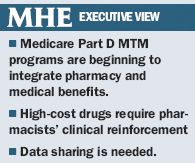Clinical consequences drive the need for pharmacy integration
More specialty drugs means more management of patient needs and more cooperation

"Coordinating pharmacy and medical benefits paints a total picture of compliance without a gap in data, and thus, impacts outcomes," says Nita Stella, senior vice president, ActiveHealth Management, a care management company headquartered in New York City. "In addition, sharing information can increase medication safety and effectiveness by triggering alerts to flag drug-to-drug interactions, contraindicated drugs and non-compliance."
Integration is an effective vehicle for identifying high-risk members and putting value-based benefit design into place. For example, an integrated system could identify high-risk members and lower copayments for those individuals or for an entire class of drugs, such as stains, to encourage compliance.
The Clinical Pharmacy Cardiac Risk Service (CPCRS) at Kaiser Permanente Colorado combines KP HealthConnect, an electronic health record (EHR), with an electronic care registry, proactive patient outreach, wellness and medication management.

"We are able to determine who has a cardiovascular event and deliver continuity of care cost-efficiently by integrating pharmacy and nursing teams with patients and their doctors and using technology and other tools to address problems," says Jon Rasmussen, chief of clinical pharmacy, cardiovascular services. "Primary care physicians and cardiologists spend an inordinate amount of time with chronic care patients, so we're looking for ways that pharmacists and nurses can relieve some of the burden. If these cardiac patients are managed consistently through collaboration, that frees up physicians to address acute issues."
Results show the number of those meeting their LDL cholesterol goals increased from 26% to 73%, and screening for cholesterol rose from 55% to 97% during an average length of participation in the program of 2.3 years.
In addition, participants in the CPCRS program had an 88% reduced risk of dying from a cardiac-related cause when enrolled in the program within 90 days of a heart attack.
When members are close to release from the program, Kaiser Permanente rehabilitation nurses set up phone calls to discuss diet, exercise, depression, smoking cessation and medications. In a seamless process, Rasmussen says, after discharge, participants work closely with clinical pharmacists for long-term medication management.
Although the program has been successful by saving lives, reducing hospitalizations and recouping investment, it hasn't been without its challenges. Among them have been getting clinicians to communicate via the EHR, developing multifunctional teams and making sure that "we target the right person with the right treatment at the right time," he says.
David Calabrese of OptumRx Talks New Role, Market Insulin Prices and Other Topics 'On His Mind'
April 13th 2023In this month’s episode of the "What's On Your Mind podcast," Peter Wehrwein, managing editor of MHE connects with the now Chief Clinical Officer of OptumRx Integrated Pharmacies, David Calabrese. In this conversation, David touches on his transition in January as OptumRx’s former chief pharmacy officer and market president of health plans and PBMs to his new role as Chief Clinical Officer where he now focuses more on things such as specialty pharmacy to home delivery — with an overall goal of creating whole-patient care. Throughout the conversation, Calabrese also touched on the market’s hot topic of insulin prices and behavioral health services within the OptumRx community, among other topics.
Listen
Upended: Can PBM Transparency Succeed?
March 6th 2024Simmering tensions in the pharmacy benefit management (PBM) industry have turned into fault lines. The PBMs challenging the "big three" have formed a trade association. Purchaser coalitions want change. The head of the industry's trade group says inherent marketplace friction has spilled over into political friction.
Read More
Briana Contreras, editor of Managed Healthcare Executive, spoke with Nancy Lurker, CEO and president of EyePoint Pharmaceuticals. Nancy shared a bit about EyePoint and how the organization’s innovative therapies are addressing patient needs through eye care, and most importantly, she addressed C-Suite positions like the CEO role. Nancy shared advice for those seeking to reach the CEO level, especially toward women in healthcare and other roles, and what it takes to run a biopharma company.
Listen
The deliberate disconnection of Change Healthcare to ring fence a cyberattack entered its seventh day today. Prescribers are finding ways to get pharmacy claims processed, and UnitedHealth Group says disruption to the dispensing of prescriptions has been minimal. But independent pharmacies want more information and protection from financial consequences from pharmacy benefit managers.
Read More